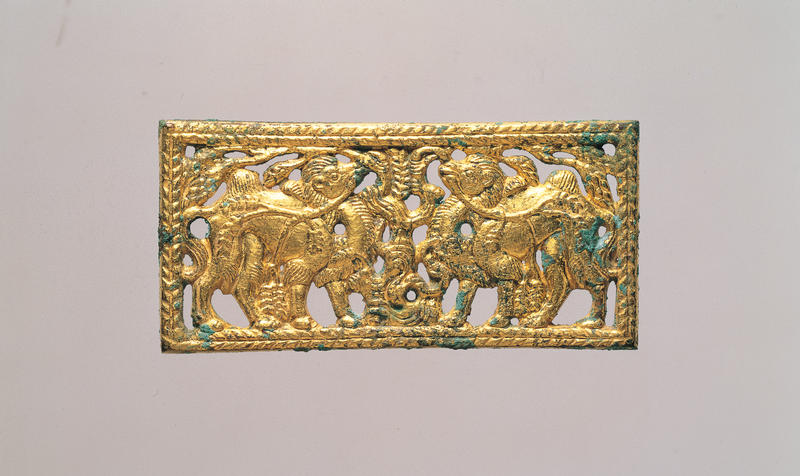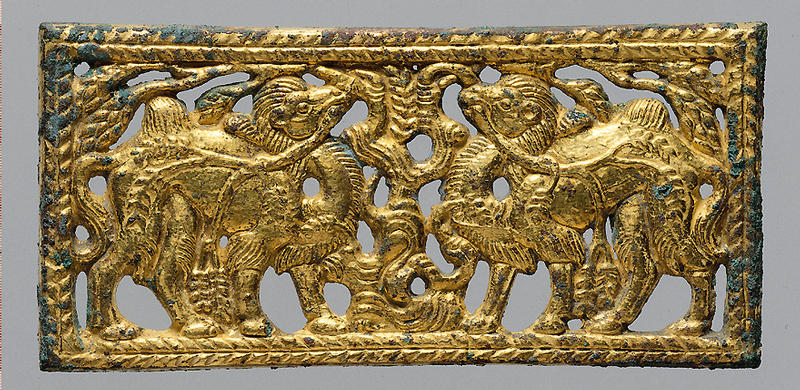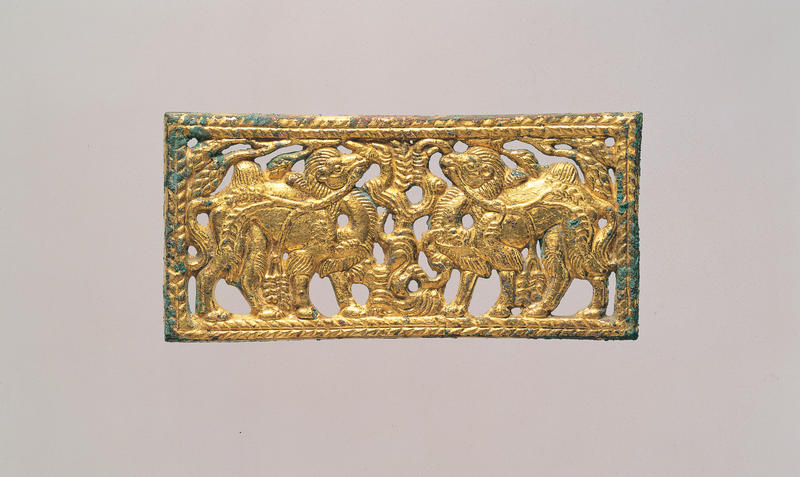帯飾板
- 中国北部
- 紀元前2-紀元前1世紀
- 青銅と金
- H-5.3 W-10.9
この二点の金銅製の透かし細工の飾り板は、樹木の両側に配された二頭の双峰駱駝で装飾されている。透かし細工の意匠の全体は編まれた縄を模した文様で縁取られている。飾り板は型で成形された蝋の原型から蝋型鋳造法で鋳造された。この原型には意匠のなかに穴が打ち抜かれていた。二つの飾り板は非常によく似ているが同一のものではない。このことは細部表現が別個の蝋型に施されていたことが分かる。それぞれの背面には垂直に取り付けられた留め金の輪が二つずつ付いている。また背面の腐食部分には繊維と布らしきものの残骸が埋まっている。漢時代に中国の北方で隣接していた遊牧民の間では、飾り板と裏打ちの間に華やかな色をした織製の帯の端を挿入するということが一般的であった。アップリケされたフエルトや準貴石が象嵌された金の帯飾板の彩り豊かな意匠を安価な模造品で生み出すためだと考えられる。
Catalogue Entry
Compositions showing confronted camels were very popular with the Xiongnu. Several versions of this composition have been excavated at burial sites at Xichagou, Xifeng Xian, Liaoning province,1 and at Daodunzi, Tongxin Xian, Ningxia,2 sites that have been dated numismatically to the second century B.C. and are associated with the Xiongnu, who raised camels as well as cattle, sheep, and horses.3
Two confronted Bactrian camels (Camelus bactrianus) flanking a tree decorate each of these two gilt-bronze openwork plaques. The whole openwork design is framed with a pattern that imitates braided rope. The plaques were cast by the lost-wax process from wax models formed in a mold, and the models contained the perforations in the design. The two plaques are very similar but not identical, indicating that details were done on the individual wax models. The back of each plaque has two vertical attachment loops.
An openwork plaque with a similar but later camel design in the Arthur M. Sackler collections has a rectangular piece of soft wood that was used to back the plaque, and retains an impression of its design in the wood.4 Several excavated examples have also been found with backing of some type.5 Such a backing for an openwork plaque seems contradictory, unless one considers the possibility that the ends of a belt made of brightly colored fabric were inserted in between the plaque and the backing to produce a colorful design that was a cheap imitation of appliqu馘 felt or a gold plaque inlaid with semiprecious stones, both of which were popular among the northern pastoral neighbors of the Han Chinese. The presence of fibers and cloth pseudomorphs embedded in the corrosion on the backs of the Shumei plaques would tend to confirm this possibility.
ECB
1. Wenwu 1960.8-9, p. 33, no. 3.
2. Kaogu xuebao 1988.3, p. 344, fig. 9.5
3. So and Bunker 1995, p. 62.
4. Bunker et al. forthcoming, p. 216, no. 233.
5. Miniaev 1995, p. 45.


